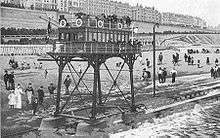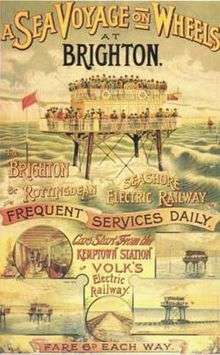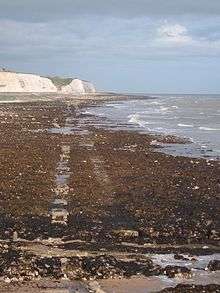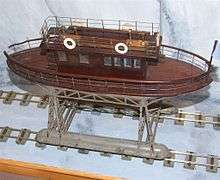Brighton and Rottingdean Seashore Electric Railway
The Brighton and Rottingdean Seashore Electric Railway was a unique coastline railway in Brighton, England that ran through the shallow coastal waters of the English Channel between 1896 and 1901.[1]



Background and construction
Magnus Volk, its owner, designer and engineer, had already been successful with the more conventional Volk's Electric Railway, which had then not been extended east of Paston Place. Facing unfavourable geography, Volk decided to construct a line through the surf from a pier at Paston Place to one at Rottingdean. This was also home to Volk's Seaplane Station which was used by his son George Herbert Volk.
The railway itself consisted of two parallel 2 ft 8 1⁄2 in (825 mm) gauge tracks, billed as 18 ft (5.5 m) gauge, the measurement between the outermost rails.[2] The tracks were laid on concrete sleepers mortised into the bedrock. The single car used on the railway was a 45 by 22 ft (13.7 by 6.7 m) pier-like building which stood on four 23 ft (7.0 m)-long legs. The car weighed 45 long tons (50 short tons; 46 t). Propulsion was by electric motor. It was officially named Pioneer, but many called it Daddy Long-Legs. Due to regulations then in place, a qualified sea captain was on board at all times, and the car was provided with lifeboats and other safety measures.
Construction took two years from 1894 to 1896. The railway officially opened 28 November 1896, but was nearly destroyed by a storm the night of 4 December. Volk immediately set to rebuilding the railway including the Pioneer, which had been knocked on its side, and it reopened in July 1897.
In use
The railway was popular, but faced difficulties. The car was slowed considerably at high tide, but Volk could never afford to improve the motors. In 1900, groynes built near the railway were found to have led to underwater scouring under the sleepers and the railway was closed for two months while this was repaired. Immediately afterward, the council decided to build a beach protection barrier, which unfortunately required Volk to divert his line around the barrier. Without funds to do so, Volk closed the railway.
In 1901 the right-of-way was broken up for construction of the barrier. One further attempt was made to raise money for a conventional over-water viaduct along roughly the same route.
Legacy

The track, car and other structures were sold for scrap, but some of the concrete sleepers can still be viewed at low tide. Eventually Volk's Electric Railway was extended onshore, covering a portion of the same distance; it remains in operation.
A model of the railway car is on display (along with a poster for the railway) in the foyer of the Brighton Toy and Model Museum.
Similar forms of transport
On rails
- St. Malo, France, had a 110-yard (100 m) single-line across the harbour, running on submerged rails, bearing a strong resemblance to Volk's Pioneer. The vehicle was cable-hauled rather than self-propelled, however.[3]
- Some ferries are arranged to operate on underwater rails, for example some diesel-powered ferries across the Amsterdam-Rhine Canal in The Netherlands.[3]
- Several fairground rides, including the riverboat rides at Disney theme parks, feature vehicles guided by submerged rails or guideways.
Other
- BARV, a tracked military vehicle designed to wade through seawater up to 3 metres (9 ft 10 in) deep.
- Sea tractor, a motor vehicle that can travel through shallow water, with driver and passengers on a raised platform.
References
- Coast. BBC2 programme. Transmitted 6 May 2013
- "Volk's Electric Sea Railway, Daddy Long Legs, The Brighton to Rottingdean Seashore Electric railway, Brighton, East Sussex, England, UK". www.urban75.org.
- Jackson, Alan (1993). Volk's Railways Brighton. Plateway Press. ISBN 1 871980 18 6.
External links
| Wikimedia Commons has media related to Brighton and Rottingdean Seashore Electric Railway. |
- Pioneer Illustration Highly detailed illustration of the Pioneer tramcar, by Conor Gorman
- The Volks Electric Railway Association, with some information about 'Daddy Long Legs'
- Daddy Longlegs Illustrated feature on Volk's Brighton to Rottingdean Seashore Electric railway with 3D animation
- Daddy Longlegs by John Roles, Brighton Museum
- Daddy Longlegs Photo by Dmitry Karpenko
- Winchester, Clarence, ed. (1936), "Brighton's electric railway"", Railway Wonders of the World, pp. 604–608 illustrated description of the railway